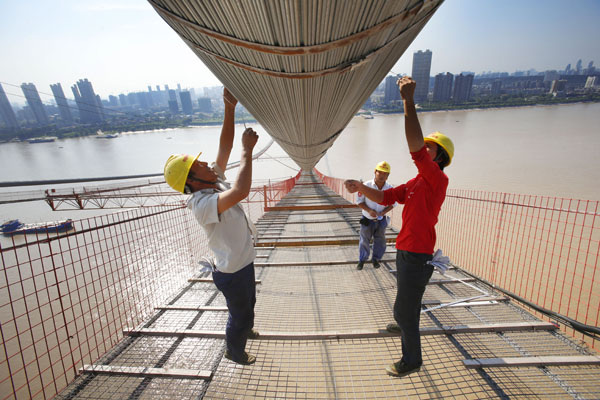

A bridge over the Yangtze River under construction in Wuhan, Hubei province. It will be the eighth Yangtze River bridge in the city and is evidence of ongoing infrastructure development. The country is making preparations for drafting the next five-year economic development plan (2016-20), which may put emphasis on boosting domestic demand.CHEN ZUO/FOR CHINA DAILY
Structural problems must be solved to support sustainable growth
China may be bracing for structural slowdown in its 13th Five-Year Plan (2016-20) as the country's top economic planner starts its mid-stage assessment of the 12th Five-Year Plan (2011-15). The analysis sets the stage for preparing a blueprint for the next period of development.
Observers said research will be getting underway this year.
The economic development guidelines for the five years from 2016 are seen as the key to determine whether the target of "establishing a moderately well-off and harmonious society" by the end of 2020 can be achieved, they said.
The target was set at the 18th National Congress of the Communist Party of China in November last year. It also aims to double its 2010 gross domestic product and per-capita income for both urban and rural residents by 2020.
As China's economy has entered into a "structural slowdown", deepening reforms and continuing the opening-up strategy will be the priority for the next five-year blueprint, said Pei Changhong, director at the Institute of Economics at the Chinese Academy of Social Sciences.
"The macroeconomic plan should focus on boosting domestic demand and solving structural problems to support sustainable growth," Pei said.
The preparation work for the 13th Five-Year Plan will end in 2015. This year will see emphasis put on researching significant issues that relate to stabilizing growth and enhancing reforms.
The National Development and Reform Commission has released survey questionnaires on its website to collect public opinion on the implementation of the 12th Five-Year Plan over the past 30 months.
The State Council - the country's cabinet - empowers the commission to set protocols and organize ways to implement the economic and social development plans.
The mid-stage assessment for the 11th Five-Year Plan started in March 2008, the first time it invited three third-party organizations - the Development Research Center of the State Council, the Center for China Study at Tsinghua University and the World Bank - to provide assessment reports.
The mid-stage assessment will influence the direction of the next plan, according to analysts.
Lu Zhongyuan, deputy head at the Development Research Center of the State Council, a government top think tank, said the next plan should consider a structural slowdown in the medium to long term.
"But the average GDP growth rate from 2016 to 2020 can still maintain 7 percent," he said. "The growth rate is not a problem for China."
However, it is more difficult to upgrade the growth pattern and deepen structural reforms.
In 2016, the launch year of the 13th Five-Year Plan, growth in the labor force in China is expected to stop, which means the contribution made by population growth will be zero, according to Lu.
In the second quarter of this year, GDP growth in the world's second-largest economy slowed to 7.5 percent from 7.7 percent in the first quarter. The whole-year growth in 2012 was 7.8 percent.
A research note from Nomura Securities Co Ltd predicted growth will continue to slow to 7.4 percent year-on-year in the third quarter, falling to 7.2 percent in the fourth.
"The current policy easing helps to mitigate downside risks but is not strong enough to boost a sharp recovery in growth," said Zhang Zhiwei, chief economist in China with the Japanese securities company.
Qu Hongbin, chief economist in China with HSBC Holdings Plc, a British financial group, said the falling range of the potential GDP growth may have been "overstated".
"Because the labor force will stop growing in the future, it will, at the very least, drag down the potential growth rate by 0.5 percentage points," Qu said.
Qu said the current economy is running below its potential growth rate - which still remains above 8 percent.
China unveils five-year plan to treat water, soil losses
2013-08-16HK to participate in 13th Five-Year Plan
2013-04-27The 11th Five-Year Plan (2006-2010)
2013-02-17The 10th Five-Year Plan (2001-2005)
2013-02-17The 9th Five-Year Plan (1996-2000)
2013-02-17The 8th Five-Year Plan (1991-1995)
2013-02-17Copyright ©1999-2018
Chinanews.com. All rights reserved.
Reproduction in whole or in part without permission is prohibited.